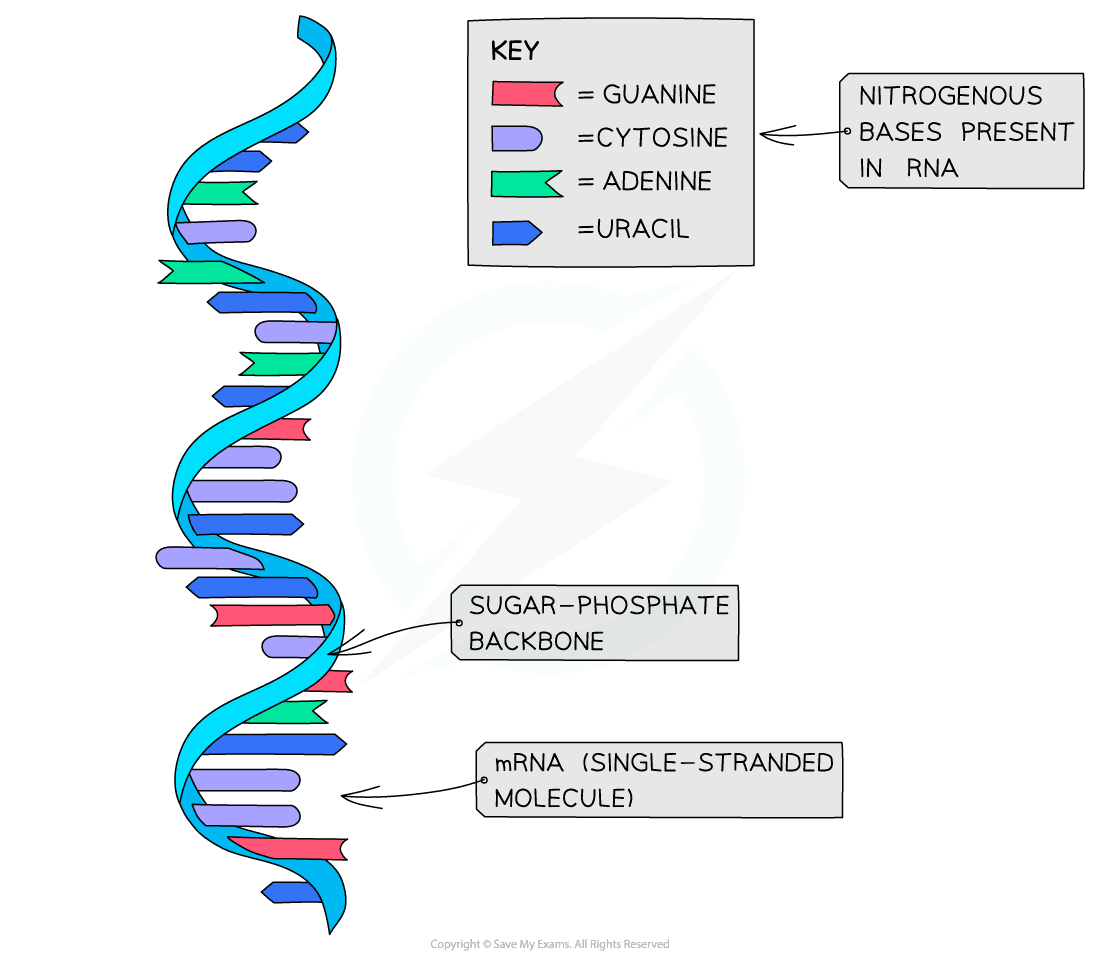Genes
- A gene is a section of DNA with a particular sequence of bases that codes for a particular sequence of amino acids
- A sequence of three bases is the code for a single specific amino acid
- The order of bases controls the order and different types of amino acids that are eventually joined together in a polypeptide chain
- These polypeptide chains (the amino acid sequences) then form a particular type of protein
- In this way, it is the order of bases in the DNA that eventually determines which proteins are produced
Types of proteins
- When the protein chain is complete it folds up to form a unique shape
- This unique shape enables the proteins to fulfil a specific function. For example, proteins can be:
- Enzymes – proteins that act as biological catalysts to speed up chemical reactions occurring in the body (e.g. maltase is an enzyme that breaks down maltose into glucose)
- Hormones – proteins that carry messages around the body (e.g. testosterone is a hormone that plays an important role in the development of the male reproductive system and development of male secondary sexual characteristics, such as increased muscle mass and growth of body hair)
- Structural proteins – proteins that provide structure and are physically strong (e.g. collagen is a structural protein that strengthens connective tissues such as ligaments and cartilage)
- There are also many other types of proteins
Transcription & Translation
- A gene is a sequence of nucleotide bases in a DNA molecule that codes for the production of a specific sequence of amino acids, that in turn make up a protein
- This process of protein synthesis occurs in two stages:
- Transcription – DNA is transcribed and an mRNA molecule is produced
- Translation – mRNA (messenger RNA) is translated and an amino acid sequence is produced
Transcription
- This stage of protein synthesis occurs in the nucleus of the cell
- Part of a DNA molecule unwinds (the hydrogen bonds between the complementary base pairs break)
- This exposes the gene to be transcribed (the gene from which a particular protein will be produced)
- An enzyme known as RNA polymerase binds to a region of non-coding DNA just in front of the gene
- RNA polymerase then makes a complimentary copy of the code from the gene by building a single-stranded nucleic acid molecule known as mRNA (messenger RNA)
- The mRNA molecule leaves the nucleus via a pore in the nuclear envelope
- Like DNA, the nucleic acid RNA (ribonucleic acid) is a polynucleotide – it is made up of many nucleotides linked together in a long chain
- Like DNA, RNA nucleotides contain the nitrogenous bases adenine (A), guanine (G) and cytosine (C)
- Unlike DNA, RNA nucleotides never contain the nitrogenous base thymine (T) – in place of this they contain the nitrogenous base uracil (U)
- Unlike DNA, RNA molecules are only made up of one polynucleotide strand (they are single-stranded)
- Each RNA polynucleotide strand is made up of alternating ribose sugars and phosphate groups linked together, with the nitrogenous bases of each nucleotide projecting out sideways from the single-stranded RNA molecule
- One example of an RNA molecule is messenger RNA (mRNA), which is the transcript copy of a gene that encodes a specific polypeptide. Two other examples are transfer RNA (tRNA) and ribosomal RNA (rRNA)

Messenger RNA (mRNA) provides a good example of the structure of RNA
Translation
- This stage of protein synthesis occurs in the cytoplasm of the cell
- After leaving the nucleus, the mRNA molecule attaches to a ribosome
- The ribosome ‘reads’ the code on the mRNA in groups of three
- Each triplet of bases on the mRNA molecule (known as a codon) codes for a specific amino acid
- In this way, the ribosome translates the sequence of bases into a sequence of amino acids that make up a protein
An overview of protein synthesis
- In the cytoplasm, there are free molecules of tRNA (transfer RNA)
- These tRNA molecules have a triplet of unpaired bases at one end (known as the anticodon) and a region where a specific amino acid can attach at the other
- There are at least 20 different tRNA molecules, each with a specific anticodon and specific amino acid binding site
- The tRNA molecules bind with their specific amino acids (also in the cytoplasm) and bring them to the mRNA molecule on the ribosome
- The triplet of bases (anticodon) on each tRNA molecule pairs with a complementary triplet (codon) on the mRNA molecule
- Two tRNA molecules fit onto the ribosome at any one time, bringing the amino acid they are each carrying side by side
- A peptide bond is then formed between the two amino acids
- This process continues until a ‘stop’ codon on the mRNA molecule is reached – this acts as a signal for translation to stop and at this point the amino acid chain coded for by the mRNA molecule is complete
- This amino acid chain (the final polypeptide) will then fold to form a protein

The triplet of bases (codon) of mRNA is read by the ribosome and amino acids are attached together in a specific sequence to form the protein
Exam Tip
In an exam, you could be asked why DNA must first be transcribed into mRNA before it can be translated into a protein. This is necessary because DNA cannot travel out of the nucleus to the ribosomes (it is far too big to pass through a nuclear pore) so the base code of each gene is transcribed into an RNA molecule called messenger RNA (mRNA).


